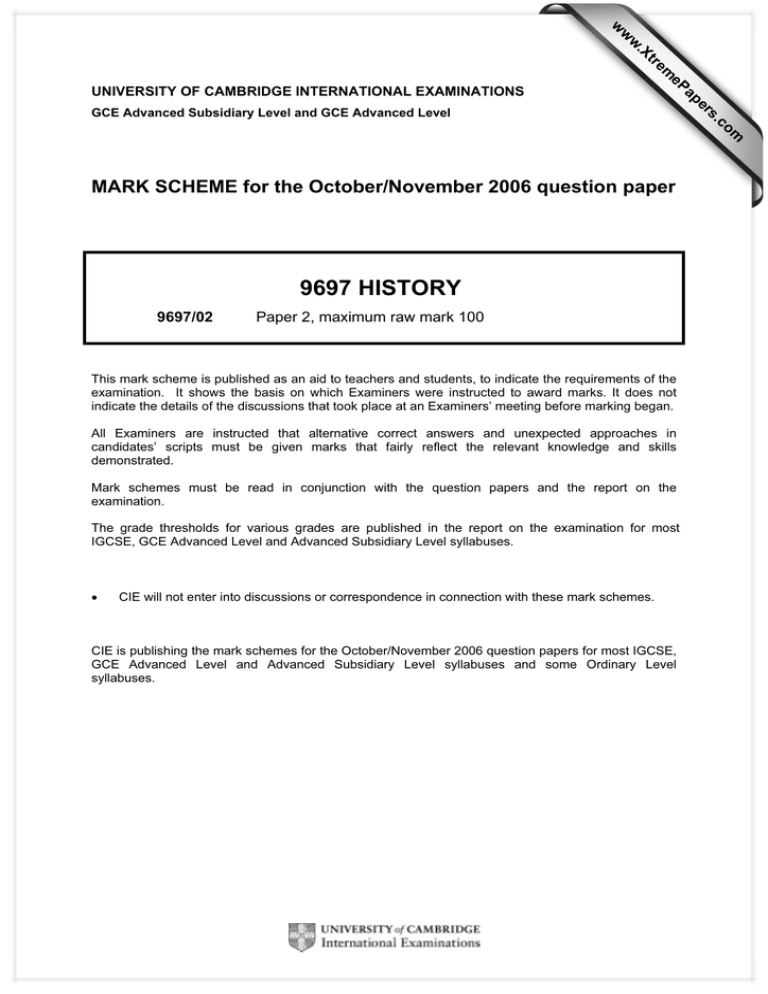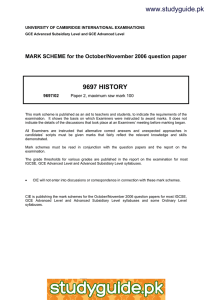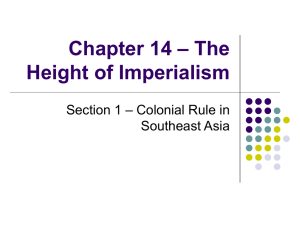9697 HISTORY MARK SCHEME for the October/November 2006 question paper
advertisement

w w ap eP m e tr .X w UNIVERSITY OF CAMBRIDGE INTERNATIONAL EXAMINATIONS om .c s er GCE Advanced Subsidiary Level and GCE Advanced Level MARK SCHEME for the October/November 2006 question paper 9697 HISTORY 9697/02 Paper 2, maximum raw mark 100 This mark scheme is published as an aid to teachers and students, to indicate the requirements of the examination. It shows the basis on which Examiners were instructed to award marks. It does not indicate the details of the discussions that took place at an Examiners’ meeting before marking began. All Examiners are instructed that alternative correct answers and unexpected approaches in candidates’ scripts must be given marks that fairly reflect the relevant knowledge and skills demonstrated. Mark schemes must be read in conjunction with the question papers and the report on the examination. The grade thresholds for various grades are published in the report on the examination for most IGCSE, GCE Advanced Level and Advanced Subsidiary Level syllabuses. • CIE will not enter into discussions or correspondence in connection with these mark schemes. CIE is publishing the mark schemes for the October/November 2006 question papers for most IGCSE, GCE Advanced Level and Advanced Subsidiary Level syllabuses and some Ordinary Level syllabuses. Page 2 Mark Scheme GCE A/AS LEVEL - OCT/NOV 2006 Syllabus 9697 Paper 02 Generic Mark Bands for Essay Questions Examiners should note the changes in the mark bands from those used in previous examinations. These changes will make it neither easier nor more difficult for candidates to reach a particular grade boundary but should facilitate decisions about grade boundaries by widening the range of marks awarded to each grade. Examiner can note the grade boundaries given below. Examiners will assess which Level of Response best reflects most of the answer. An answer will not be required to demonstrate all of the descriptions in a particular Level to qualify for a Mark Band. In bands of 3 marks, examiners will normally award the middle mark, moderating it up or down according to the particular qualities of the answer. In bands of 2 marks, examiners should award the lower mark if an answer just deserves the band and the higher mark if the answer clearly deserves the band. Band Marks Levels of Response 1 21-25 The approach will be consistently analytical or explanatory rather than descriptive or narrative. Essays will be fully relevant. The argument will be structured coherently and supported by very appropriate factual material ideas. The writing will be accurate. At the lower end of the band, there may be some weaker sections but the overall quality will show that the candidate is in control of the argument. The best answers must be awarded 25 marks. 2 18-20 Essays will be focused clearly on the demands of the question but there will be some unevenness. The approach will be mostly analytical or explanatory rather than descriptive or narrative. The answer will be mostly relevant. Most of the argument will be structured coherently and supported by largely accurate factual material. The impression will be that a good solid answer has been provided. 3 16-17 Essays will reflect a clear understanding of the question and a fair attempt to provide an argument and factual knowledge to answer it. The approach will contain analysis or explanation but there may be some heavily descriptive or narrative passages. The answer will be largely relevant. Essays will achieve a genuine argument but may lack balance and depth in factual knowledge. Most of the answer will be structured satisfactorily but some parts may lack full coherence. 4 14-15 Essays will indicate attempts to argue relevantly although often implicitly. The approach will depend more on some heavily descriptive or narrative passages that on analysis or explanation, which may be limited to introductions and conclusions. Factual material, sometimes very full, will be used to impart information or describe events rather than to address directly the requirements of the question. The structure of the argument could be more organised more effectively. 5 11-13 Essays will offer some appropriate elements but there will be little attempt generally to link factual material to the requirements of the question. The approach will lack analysis and the quality of the description or narrative, although sufficiently accurate and relevant to the topic if not the particular question, will not be linked effectively to the argument. The structure will show weaknesses and the treatment of topics within the answer will be unbalanced. 6 8-10 Essays will not be properly focused on the requirements of the question. There may be many unsupported assertions and commentaries which lack sufficient factual support. The argument may be of limited relevance to the topic and there may be confusion about the implications of the question. 7 0-7 Essays will be characterised by significant irrelevance or arguments which do not begin to make significant points. The answers may be largely fragmentary and incoherent. Marks at the bottom of this Band will be given very rarely because even the most wayward and fragmentary answers usually make at least a few valid points. © UCLES 2006 Page 3 Mark Scheme GCE A/AS LEVEL - OCT/NOV 2006 Syllabus 9697 Paper 02 [Note: generic mark bands will be used in addition to this mark scheme.] L1 WRITES ABOUT THE HYPOTHESIS, NO VALID USE OF SOURCES [1-5] These answers will be about postwar Singapore, and the upper band will discuss the importance of left-wing parties. These answers will ignore the question i.e. they will not use the sources as information/evidence to test the given hypothesis. Include in this level answers which give information taken from the sources, but only producing an account of events rather than exploring the hypothesis. L2 USES INFORMATION TAKEN FROM THE SOURCES TO CHALLENGE OR SUPPORT THE HYPOTHESIS [6-8] These answers use the sources as information rather than evidence, i.e. sources are used at face value only with no evaluation/interpretation of context. e.g. ‘Yes, Source B demonstrates that the British were largely content to maintain the status-quo. Or No, Source A shows that British policy was geared towards ending colonial control across the world’. L3 USES INFORMATION FROM SOURCES TO CHALLENGE AND SUPPORT THE HYPOTHESIS [9-13] These answers know that testing the hypothesis involves both attempting to confirm or to challenge it. However, sources are still used only at face value. e.g. ‘There is evidence for and against the view that the colonial authorities did not seek or desire political change. Source E describes how the British were reluctant to cede formal control. On the other hand, Source A that British policy was geared towards ending colonial control across the world’. L4 BY INTERPRETING/EVALUATING SOURCES IN CONTEXT, FIND EVIDENCE TO CHALLENGE OR SUPPORT THE HYPOTHESIS [14-16] These answers are capable of using sources as evidence, i.e. demonstrating their utility in testing the hypothesis by interpretation then in historical context rather than simply accepting them at face value (as in L3). e.g. ‘I think that the colonial authorities did not seek or encourage political change. Source B that the reforms and measures put in place by the authorities did little to change the nature of power in the colony, and Source D indicates that the British emphasised stability in Singapore in contrast to the upheavals in other Southeast Asian states. As an historian, the author of Source B is able to reflect on these events with hindsight, access sources and documents not available to the public at the time, and approach the question with an historian’s objectivity. Source D on the other hand, whilst not referring directly to the issue in the question does demonstrate how the colonial authorities viewed themselves, i.e. as more concerned with the maintenance of trade than with political reform’. L5 BY INTERPRETING/EVALUATING SOURCES IN CONTEXT, FINDS EVIDENCE TO CHALLENGE AND SUPPORT THE HYPOTHESIS [17-21] These answers know that testing the hypothesis involves attempting both to confirm and challenge the hypothesis, and are capable of using sources as evidence to do this (i.e. both confirmation and challenge are done at this level). e.g. [As L4 but] ‘However, some of the sources do suggest that reforms were in progress. Source C shows that the Colonial authorities were trying to develop trades unions, and this does seem to be in-line with the overall aim of British Colonial policy as outlined in Source A which emphasised political development. Even Lee Kuan Yew in Source E does acknowledge that this was the British attitude to independence’. © UCLES 2006 Page 4 Mark Scheme GCE A/AS LEVEL - OCT/NOV 2006 Syllabus 9697 Paper 02 L6 AS L5 PLUS EITHER (a) EXPLAINS WHY EVIDENCE TO CHALLENGE/SUPPORT IS BETTER/PREFERRED, OR (b) RECONCILES/EXPLAINS PROBLEMS IN EVEIDENE TO SHOW THAT NEITHER CHALLENGE NOR SUPPORT IS TO BE PREFERRED [22-25] For (a) this builds upon L4 and L5, but the argument must be that the evidence for challenging/supporting is better/preferred. This must involve a comparative judgment i.e. not just why some evidence is better, but why other evidence is worse. For (b) include all L5 answers whilst using the evidence to present a nuanced response which may modify the hypothesis (rather than simply seeking to support/contradict) in order to improve it. e.g. ‘British policy may have emphasised stable colonial development towards eventual political independence, as Sources B and D illustrate. Indeed the British may have believed themselves to be pursuing this policy, as Source A indicates. However, according to both the historian’s perspective in Source B, as well as the recollections of a leading figure in the independence movement in Source E, these measures were largely ineffective. British reforms, in attempting to maintain stability (Source D), appeared if anything to reinforce, rather than change, the nature of Colonial rule’. For the highest level in both (a) and (b), the conclusion should be based on an overall assessment of the different opinions/perceptions shown in the sources or by establishing different criteria for support/contradiction. © UCLES 2006 Page 5 Mark Scheme GCE A/AS LEVEL - OCT/NOV 2006 Syllabus 9697 Paper 02 Section B 2 ‘Colonial disruption of traditional authority caused a power vacuum which created new forms of indigenous political leadership.’ Discuss with reference to the period 1870 to 1940. Knowledge: Candidates should demonstrate knowledge of the structure of traditional societies in Southeast Asia up to 1870. Candidates should then examine the impact of colonialism in terms of the changes to existing social practices. Issues: To what extent did the colonial powers bring about modernisation/were the colonial powers necessarily a modernising force? Colonial powers were in some cases happy to work within existing traditions (as they saw them) in order to achieve their goals, whereas in other cases they were absolutely resistant to them, leading to the effective abolition of traditional practices. Strong candidates may consider whether in some cases the abolition of traditional practices did not have positive consequences for indigenous populations. Examples: Indirect rule, the one system which actually sought to preserve and operate through traditional structures, only operated in Malay States – indirect rule under the auspices of the Residential system. Even here, local rulers had to operate with the consent of British power. However, CRUCIALLY, this did not extend to matters relating to religion or local customs. Two dominant but opposed French theories on colonial policy. One emphasising the preservation of traditional social customs in the colonies and ruling through partnership between the indigenous peoples and the colonial authorities. The other emphasising the necessity of indigenous ‘assimilation’ into the French model of society – and therefore an end to traditional practices. In practice, French largely exercised policy of assimilation. Loss of cultural heritage in Burma as it was absorbed into British India. Loss included replacement of traditional authorities, monarch, local headmen, Buddhist monks. Burma and Malaya were also subject to immigration, causing further disruption to traditional social practices. Traditional social practices were sometimes highly negative, such as debt slavery and local warlordism. Although these were ‘lost’, this had a largely positive effect on the indigenous populations. Economic practices: Assimilation of Southeast Asia into the world economy as a function of imperialism, resulting in the demise of small-holding. Candidates may also point out that Siam avoided many of the worst problems brought on by imperial powers by undergoing its own modernisation. This meant that traditional governmental and social authority remained largely intact alongside modern developments. Candidates should examine at least two countries and examine the different European approaches. e.g. 1 Malaya and the introduction of direct rule. e.g. 2 Burma where the traditional elites were replaced by direct rule. e.g. 3 Thailand where Europeans became more invasive. e.g. 4 Indonesia where indirect rule was largely maintained. e.g. 5 Vietnam had oppressive direct rule by French. © UCLES 2006 Page 6 Mark Scheme GCE A/AS LEVEL - OCT/NOV 2006 Syllabus 9697 Paper 02 3 Assess the impact of European colonialism on the development of urban centres of administration and commerce from 1870 to 1914. Issues: Did European colonialism leave a mark upon the geographical landscape of Southeast Asia? Candidates will examine to what extent urbanisation was a corollary of Imperial policy. They will examine whether the period in question presaged any significant changes in the urban landscape. Knowledge: In certain cases such as the French in Indochina, urban changes were organisational and aesthetic. In other cases, industrialisation and trade fundamentally changed the form and function of urban centre, including the development of new cities. Dutch East Indies: the dispersal of the island made small-scale costal settlements almost inevitable. Administrative and commercial settlements tended to follow the exploitation of resources, and the Dutch desire for a wider colonial periphery. Such peripheral expansion was particularly prominent in the late nineteenth century, with new administrative communities emerging in East Sumatra, and Dutch conflicts over Aceh. Indochina: Given the French administration’s centralisation of administration under the direct rule of the Governorgeneral, the urban areas always dominated the administration, even before economic urbanisation. French declared Hanoi the capital, and established quartiers as in may other French colonial cities. The French quarter was the administrative centre, which also housed the university. By contrast, the commercial quarter was largely Vietnamese and Chinese populations. Kuala Lupa emerged almost entirely due to its proximity to mining resources which became crucial to the entire colonial economy from the late nineteenth century. Although already a vital commercial base for the British in the nineteenth century, Singapore’s importance increased with the opening of the Suez Canal. The port city increased in importance still further with the French colonisation of Indochina as well as the extension of Spanish rule in the Philippines. Additionally, Singapore began to diversify from simply an exchange port to a point of preliminary industrial activity, such as tin smelting and rubber processing. 4 To what extend did the Great Depression of the 1930s affect the economic situation of the peoples of Southeast Asia? Issues: Candidates must explore how changes in the economies of Southeast Asia in the period before the Depression meant that the different peoples were affected in radically divergent ways. They may also explore how the reactions of the Colonial powers affected the impact of the Depression in these different contexts. Knowledge: Context, by the 1930s, populations of Southeast Asia had changed considerably from traditional social roles. Large influx of peasants into cities, and into the Colonial economy by becoming workers for colonial companies. The countryside was in a state of crisis, with traditional peasant agriculture no longer compatible with the cash economy. Philippines: The depression saw the end of dependence on and support by the USA. As the US closed its economic borders during the depression, US producers argued that cheaper goods from the Philippines would undermine their recovery. As the US banned tariff free imports, goods from the Philippines were subject to tariffs, whereas imports from the USA were tariff free. This deepened economic depression and closed many successful enterprises that lost markets and gained competitors. The great depression aggravated the already debt-burdened peasantry. Land-reform had not taken place due to the influence of large-scale land-owners over colonial authorities, especially in Cochin China, Burma and the Philippines. The trade depression meant that crops were no longer worth producing; this led to malnutrition during the 1930s, especially in Java and Indochina. Indochina: Due to a mercantilist closed colonial economy, the economy here moved ever more towards the metropole. Traditional industries were left to expire, as the colony traded almost exclusively with the French. The colony and people became economic dependants of the French. East Indies: During the Depression, the Dutch used to capacity of the colonies to offset problems in the metropole. In the Dutch East Indies, the currency was overhauled and the colony was forced to export its products in a weak position compared to countries which had devalued. Trade slump was therefore transferred from the Netherlands to the East Indies. Western forms of employment no longer paid, and therefore the population returned to villages which could not cope with the influx. © UCLES 2006 Page 7 Mark Scheme GCE A/AS LEVEL - OCT/NOV 2006 Syllabus 9697 Paper 02 5 How far was the success of the Nationalist movements in Southeast Asia dependent upon the personalities of their leaders? Issues: Candidates should examine how much nationalist movements were affected by individual leaders. Stronger candidates will compare the role of individual leaders to other factors such as mass support, and the role of external forces such as the policies of colonial powers and the effects of war for instance. Knowledge: Candidates may refer to these or other examples. Philippines: Although nationalist leaders were prominent, under American control nationalist ambitions relied much more upon an inter-dependence with the colonial authorities, who quickly implemented measures for the independence of the territory. Indochina: The pragmatism of Communist leaders, particularly Ho, Tran van Giau, Pham Van Dong and others provided leadership for the nationalist movement as a whole. Communist leader’s willingness to incorporate nationalist movements within their own organisation led to a most effective resistance to colonial control Additionally, Ho and others were willing to work with the allies during the Second World War, but moved to colonial resistance after the conflict in order to achieve their ends. Candidates may also examine the military doctrines of Giap and their effectiveness against the French in particular. Indonesia: Despite mass support for both movements, the Muslim party SI and the Communists PKI could not provide the united leadership to challenge the Dutch. By contrast, Sukarno in uniting Nationalism with these others in the 1930s, as well as co-operating with Japanese authorities during the occupation, was able to cement his role as leader, permitting political recognition at the end of the conflict, which the subsequent Dutch intervention was unable to challenge effectively. Nationalism in Malaya was very insignificant. Instead, loyalties were to local and ethnic leaders, who did not seek to unite as a single Nationalist movement. Burma: In this context, no single leader emerged to dominate nationalist ambitions. This was a consequence of a changing political agenda led by the British which related strongly to changes occurring in India. From the 1920s, the nationalist movement was split between those who accepted British reforms, such as the imposition of a Dyarchy system of government, and those on the left, such as the Dobama Asiayone, who campaigned for greater autonomy. 6 Was the defeat of Japan by the Allies a help or hindrance to nationalist movements in Southeast Asia? [You must not use examples drawn from Singapore to support your answer.] Issues: Candidate should explore whether the changed circumstances at the end of the Second World War had a knock-on effect on the fortunes of the nationalist movement. Knowledge: At the end of the War, despite large armies in the region, the allies did not have the man-power to police the vast territories, and so deferred control to local administration in Indonesia and Indochina. In Indonesia though, local nationalist administrators had already agreed quasi-autonomy from the Japanese. In addition, the sudden end to the war meant that allies, especially British and French, plans to re-occupy parts of Southeast Asia had not been completed. In Malaya, the Communists were staking their claim to governance, which forced the British to take a more cautious line, especially given the strength of Communist guerrilla forces. Burma was re-captured before the Japanese capitulation. However, the independence of the administration under the Japanese meant that some in Britain viewed the Burmese authority as collaborationist. This created tensions between the colonial authorities and the Nationalist, which delayed formal independence for three years. Indochina was made more complicated by the involvement of the French at the end of the War. The continuing allied presence in Asia after the war fomented Communist backed resistance, which implicated Cold War issues in nationalist struggles, especially as the Soviet Union had been excluded from the allied campaigns to defeat Japan. This prolonged the struggle in Indochina especially. Here, American assistance to the French in the early 1950s, and the eventual intervention, was a direct result of American dominance in the region after the victory over Japan. A related issue here is the success of the Communists in China. Although they did not defeat the Japanese on the Chinese mainland. Communist forces were strengthened by allied aid during the war, further exacerbating the Cold War climate in subsequent years. © UCLES 2006 Page 8 Mark Scheme GCE A/AS LEVEL - OCT/NOV 2006 Syllabus 9697 Paper 02 7 How far were the ethnic minorities a cause of political instability within the newly-independent Southeast Asian states? Issues: Did ethnic minorities form into political groupings in the period after independence? if so why? and did such political movements act as a force for stability of instability? Knowledge: Indonesia: Sukarno was able to integrate the dominant Muslim group into his own regime in a response to the challenge by the (atheistic) Communists in the postwar period. Thailand: In this context, the economy was sharply divided between those groups close to the source of power at the centre of government, and those on the peripheries, especially in the Northeast of Thailand. Here unrest was fomented by economic inequalities, as well as a preponderance of various ethnic groups. As the state developed in the 1950s, increasing intervention in this region by the central government was seen as a cause of increased support for the Communist movement so government intervention meant that various ethnic groups tended to unite in common cause against the centre, rather than against other groups. Malaysia: The structure of Malaya society is defined by ethnic differences. These differences though have been largely addressed by Malaya politics, which bred a stable parliamentary regime. This has occurred despite the fact that the party system grew along distinctly racial lines. The most significant group was the Malaya Chinese, who formed the 90% of the Malay Communist Party. The British were able to gain allies in the struggle against communism by emphasising these ethnic differences. 8 How effective were ASEAN’s attempts at regional co-operation in Southeast Asia up to 1980? Issues: Candidates should discuss what united ASEAN members, and examine how this unity was tested by various issues which ASEAN had to address in the years after its foundation. Stronger candidates will examine how ASIAN moved from being an organisation based on regional security, into greater economic and political integration, and the subsequent effect of this change upon the unity of the organisation. Knowledge: ASEAN was established against the backdrop of continuing Western intervention in Southeast Asia, particularly with reference to security issues. It intended to neutralise Southeast Asia by addressing pan-Asian security issues, and thus, in the long-run, diminishing the need for a strong Western military presence. The looseness of the organisation has been seen to be one of its biggest strength. Indonesia, as by far the largest and most dominant member, did not over-excerpt its political dominance, and so allowed for regional differences which would not damage the overall unity of the organisation. ASEAN unity was particularly challenged by the impact of the success of the Communists in Vietnam, which threatened to increase outside (especially Soviet) influence in the region, which Indonesia feared. However, given the circumstances, ASEAN foreign ministers agreed that it was better to maintain a fragile consensus than destroy the organisation. Such agreement was further tested with the Vietnamese invasion of Cambodia. ASEAN’s response was once again to seek a fragile consensus, time with the aid of the United Nations. Again, agreement on this invasion was reached despite the reservations of important ASEAN members, especially Malaysia and Indonesia. © UCLES 2006






